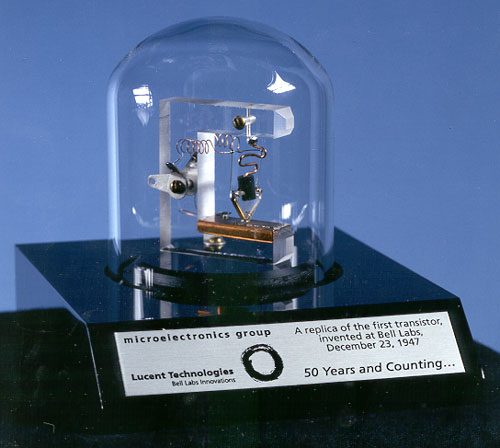
John Bardeen, William Shockley and Walter Brattain at Bell Labs
On May 23, 1908, American physicist and electrical engineer John Bardeen was born. Bardeen is the only person to have won the Nobel Prize in Physics twice: first in 1956 with William Shockley and Walter Brattain for the invention of the transistor;[6] and again in 1972 with Leon N Cooper and John Robert Schrieffer for a fundamental theory of conventional superconductivity known as the BCS theory theory.
“Science is a field which grows continuously with ever expanding frontiers. Further, it is truly international in scope. Any particular advance has been preceded by the contributions of those from many lands who have set firm foundations for further developments. The Nobel awards should be regarded as giving recognition to this general scientific progress as well as to the individuals involved.
Further, science is a collaborative effort. The combined results of several people working together is often much more effective than could be that of an individual scientist working alone.”
– Banquet Speech, John Bardeen, The Nobel Prize in Physics 1972
John Bardeen – Youth and Education
John Bardeen attended the University of Wisconsin–Madison and earned his Bachelor of Science degree in electrical engineering in 1928, and his Master’s degree in 1929. Bardeen wrote his thesis on a problem in solid-state physics, under physicist Eugene Wigner. He spent three years working at Harvard University and during that time, worked with John Hasbrouck van Vleck and Percy Williams Bridgman on problems in cohesion and electrical conduction in metals, and also did some work on level density of nuclei. In 1936, John Bardeen received his Ph.D. in mathematical physics from Princeton.
Working at Bell Labs
At the solid-state physics group at Bell labs, John Bardeen started working in 1945 where Bardeen and his colleagues were given the task to seek a solid-state alternative to fragile glass vacuum tube amplifiers. In order to do so, Bardeen suggested a theory that invoked surface states that prevented the field from penetrating the semiconductor. By 1946 they had enough results that Bardeen submitted a paper on the surface states to Physical Review.
The Point-Contact Transistor
In 1947, Walter Brattain [5] and John Bardeen created a point-contact transistor that achieved amplification. Bell Labs’ patent attorneys started to work on the patent applications a few weeks later. The attorneys discovered that Shockley’s field effect principle had been anticipated and patented in 1930 by Julius Lilienfeld. Further, Shockley took great credit for the invention of transistor, which led to a deterioration of Bardeen’s relationship with Shockley. While Bell Labs presented Shockley, Brattain, and Bardeen as a team, Shockley eventually infuriated and alienated Bardeen and Brattain, and he essentially blocked the two from working on the junction transistor. In 1956, John Bardeen shared the Nobel Prize in Physics with William Shockley of Semiconductor Laboratory of Beckman Instruments and Walter Brattain of Bell Telephone Laboratories “for their researches on semiconductors and their discovery of the transistor effect”.

A stylized replica of the first transistor invented at Bell Labs on December 23, 1947
Leaving Bell Labs
John Bardeen left Bell Labs in 1951, joining the engineering faculty and the physics faculty at the University of Illinois at Urbana–Champaign. He was appointed Professor of Electrical Engineering and of Physics, his first Ph.D. student being Nick Holonyak. At Illinois, Bardeen established two major research programs, one in the Electrical Engineering Department dealing with experimental and theoretical aspects of semiconductors and one in the Physics Department dealing with theoretical aspects of macroscopic quantum systems.
The Second Nobel Prize
In 1972, John Bardeen shared the Nobel Prize in Physics with Leon N Cooper of Brown University and John Robert Schrieffer of the University of Pennsylvania “for their jointly developed theory of superconductivity, usually called the BCS-theory”. Bardeen became the first person to win two Nobel Prizes in the same field. The Bardeen–Cooper–Schrieffer theory describes superconductivity as a microscopic effect caused by a condensation of Cooper pairs into a boson-like state. It is is also used in nuclear physics to describe the pairing interaction between nucleons in an atomic nucleus.
In 1990, John Bardeen appeared on LIFE Magazine’s list of “100 Most Influential Americans of the Century”, he died in 1991.
Spark of Genius: The Story of John Bardeen at the University of Illinois, [7]
References and Further Reading:
- [1] “Biography of John Bardeen”. The Nobel Foundation.
- [2] John Bardeen at Britannica Online
- [3] John Bardeen Biography
- [4] John Bardeen at Wikidata
- [5] Walter Houser Brattain and the Transistor, SciHi Blog
- [6] The Birth of the Transistor, SciHi Blog
- [7] Spark of Genius: The Story of John Bardeen at the University of Illinois, University of Illinois Urbana-Champaign @ youtube
- [8] Oral History interview transcript with John Bardeen 13 February 1980, American Institute of Physics, Niels Bohr Library and Archives
- [9] Associated Press Obituary of John Bardeen as printed in The Boston Globe
- [10] Bardeen, J. (1980). “Reminiscences of Early Days in Solid State Physics”. Proceedings of the Royal Society of London. Series A, Mathematical and Physical Sciences. 371 (1744): 77–83.
- [11] Daitch, Vicki; Hoddeson, Lillian (October 28, 2002). True Genius: The Life and Science of John Bardeen. Joseph Henry Press.
- [12] Pines, David (2009). “Biographical Memoirs: John Bardeen” (PDF). Proceedings of the American Philosophical Society. 153 (3): 287–321.
- [13] Timeline of Quantum Physicists, via DBpedia and Wikidata






Pingback: Whewell’s Gazette: Year 03, Vol. #41 | Whewell's Ghost